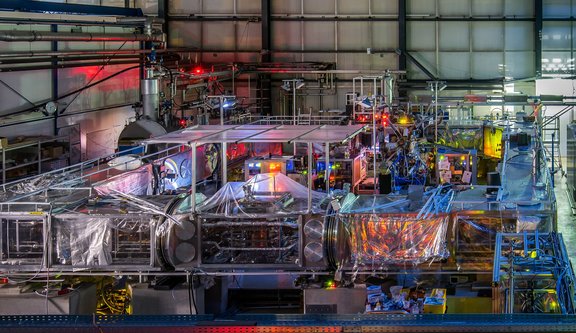Cosmic rays are high energy particles that traverse through the Galaxy and interact with its matter. In the cold and dilute interstellar gas, they are the dominant ionization source for hydrogen. Through this ionization, cosmic rays play a central role in initiating astrochemistry in the many phases of the interstellar medium and impact the process of star formation. How often ionization takes place, is quantified by the cosmic ray ionization rate, an important parameter for both chemical and dynamical models in these environments. However, the direct measurement of the cosmic ray ionization rate is not feasible. Instead, astronomers derive it from observed abundances of specific surrogate molecules. This, however, relies on the detailed knowledge of their chemical pathways.
To probe for the cosmic ray ionization rate in cold molecular clouds, especially in their diffuse outer parts, astronomers use the abundance of the hydroxyl cation OH+. Its production is proportional to the cosmic ray ionization rate of hydrogen, and it is therefore an ideal species to infer the ionization rates. However, the destruction of OH+ via dissociative recombination, one of its dominant chemical pathways in the models, had been built on unreliable data. As quantum mechanical models are quite complex, laboratory measurements of these destruction pathways are the most reliable source. So far, part of the OH+ chemistry was only measured with “hot” molecules at best at room temperature, far different from the conditions prevalent in the cold interstellar medium.
In a new study, scientists could for the first time present measurements for the dissociative recombination of OH+ at very low temperatures. They made sure that the molecule is in its rotational, vibrational, and electronic ground states, replicating interstellar conditions. For these measurements, the scientist used the recently develop Cryogenic Storage Ring, CSR, at the Max-Planck-Institut für Kernphysik in Heidelberg, Germany.
The CSR is a purely electrostatic storage ring with a circumference of 35 meter, that can store atomic and molecular ions for hours at a time. What makes it world-wide unique is its capability to be run at cryogenic temperatures of down to 4 K, thus mimicking the conditions in the interstellar medium.
The measurements performed here on dissociative recombination of OH+, now found it to be a factor of 5 times faster compared to previous “hot” measurements. This has important implications on the astrochemistry models used for the interstellar clouds, as the OH+ abundance is used to directly infer the cosmic ray ionization rate of hydrogen. With the new data measured at CSR, astronomers now conclude a larger cosmic ray ionization rate, by about a factor of 2 compared to previous estimates for diffuse clouds. Nevertheless, the cosmic ray ionization rate is not necessarily the same in all environments.
Observations have indicated that the cosmic ray ionization rate can be lower in denser environments, when compared to their more dilute counterparts. This is interpreted as a shielding of cosmic rays as they propagate through and interact with an interstellar cloud. Lower cosmic ray ionization rates in dense cores result in significantly different chemical reaction rates and therefore have a large impact on our view of molecular formation in the universe.
Original publication:
Dissociative Recombination of Rotationally Cold OH+ and Its Implications for the Cosmic Ray Ionization Rate in Diffuse Clouds
Ábel Kálosi et al.
The Astrophysical Journal Letters, Volume 955, Number 2
DOI 10.3847/2041-8213/acf71d
Weblinks:
